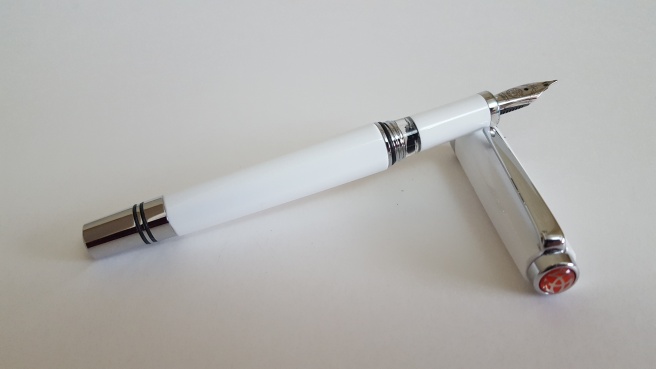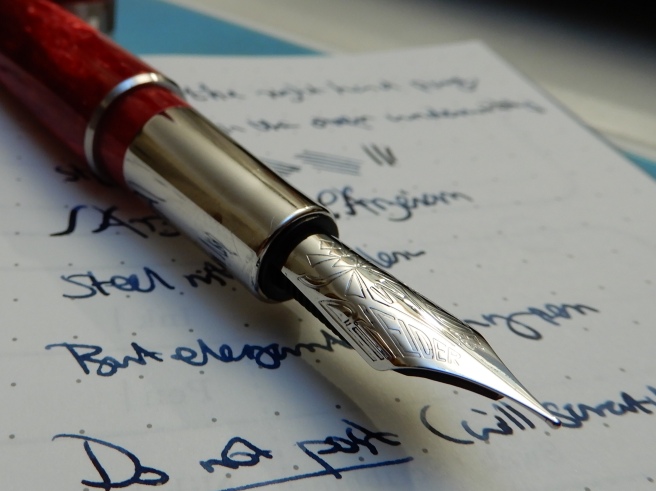This pen was part of my haul from the London pen show last October and has now been in light use for over six months.
I am very fond of TWSBI’s fountain pens and already owned a Vac 700, a Diamond 580 and an Eco, all of which I enjoy using. The London show was my first time to handle the newly modified Classic. I had to make a swift decision whether to go for the white or the light blue (which was adorable) but settled on the white version on the ground that it might be less jarring on the eyes in a workplace scenario.

For its first inking, I chose a new bottle of KWZ Azure #4, also bagged at the same pen show. However, I had been playing with the pen prior to filling it, disassembling the section and evidently had not tightened it enough on putting it back together again, as the ink oozed out of the gaps and over my fingers.
This was very easily remedied, by flushing and cleaning the pen, tightening it up a little bit harder this time and re-inking. Note, that when unscrewing the section, there is a little rubber O ring at one end, which might be mistaken for a smear of black ink. Take care not to lose this.
Like the Diamond 580 or the Eco, this is another piston filler, but not a demonstrator. Instead there is a modest sized ink window, next to the metal threads for the cap. The cap also has metal threads, which might make you worry about causing scratches when posting the cap. However, there is no need for concern, as the cap has been re-designed to post very neatly over the piston knob, where it clicks into place above a couple of rubber O rings. Used in this way, the pen is a very comfortable weight and length (about 166mm). You can however use it without the cap posted, being around 125mm in length.
The material is a pleasant, hard-wearing resin of some sort which, in the white finish, almost looks like porcelain. The cap, the barrel and the cap band are octagonal. The shiny chrome furniture makes a nice contrast and there is the distinctive red TWSBI logo in the finial, which makes the pen stand out in the pen cup. The pocket clip is strong and firm. I always find myself wanting to align the flat surfaces whenever I post the cap.

The steel nib on this model is smaller than that of the VAC 700 or Diamond 580 but looks proportionate to the size of the pen. I chose a medium and it writes very well – smooth and with good flow, but fairly firm.
As with other TWSBIs, this comes with a little wrench to enable you to unscrew the piston mechanism should you wish to do so. I did this, only for the first time, late at night, whilst tired and a bit reckless and impatient. I made the “Classic” mistake of finding out the hard way that I did not know how to put the piston back together.
This set me thinking about the term “penmanship” which should denote not only good handwriting, but other qualities including care, wisdom, patience and appreciation for one’s fountain pens. Happily with the aid of one of SBRE Brown’s disassembly line videos on Youtube, I was soon able to reassemble the pen.
For much of the last six months, I have been using this pen with Sailor Kiwa guro, a black pigment ink which is safe for fountain pens. It is very useful to have a waterproof ink sometimes for such duties as writing addresses on envelopes.
However, having recently received a new 110ml bottle of Registrar’s Ink (a blue black iron gall ink) I decided to try this in the TWSBI. I am delighted with the results. I may use this pen when I next register a marriage at our local church. The white pen should look nice in the “signing the register” photos. I will make sure that the pen is properly assembled this time.
Likes and dislikes.
In summary, this is an attractive, medium sized fountain pen, which performs well. I particularly like the ink window. It is useful that you can (if you wish), strip the pen for cleaning and maintenance, like a Bren gun, although there is no necessity to do so, particularly the piston, which should serve well for years without maintenance.
My only criticism would be of the section in that it would perhaps be more aesthetically pleasing if it were not so perfectly straight. Looked at in profile, it does not look quite right. A slight curve to make a nice finger rest or a slight tapering towards the nib would help the look, although it is comfortable to hold as it is.
The price at the London pen show was £40.00, which makes it a little more than the Eco but less than the Diamond 580 or Vac 700. I like it a lot.













